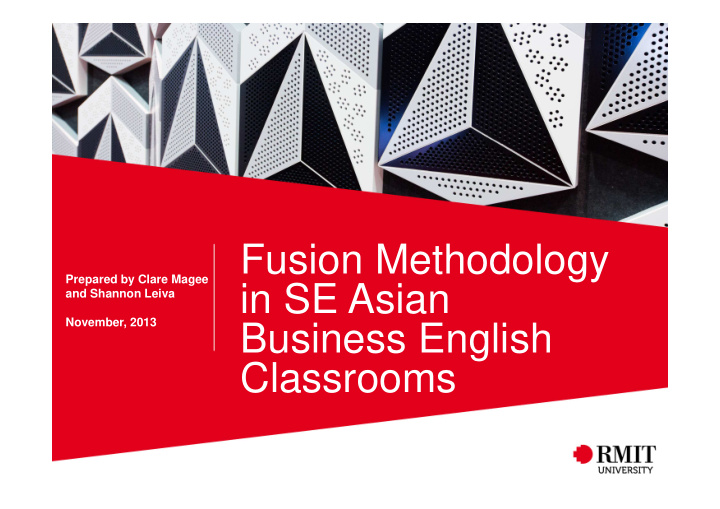



Fusion Methodology Prepared by Clare Magee in SE Asian and Shannon Leiva November, 2013 Business English Classrooms
Overview • Cultural influences on • Cultural influences on learning – SE Asian Context learning – SE Asian Context 1 • The Fusion Approach 2 • 3 Fusion Strategies • 3 Fusion Strategies 3
“Not all learners wish to behave in the way of native speakers and teachers must respect the learners’ system of beliefs and values” FALSE? TRUE? TRUE? (Eslami-Rasekh, 2005, p.207).
Client Profile: Global
FUSION Learners Teaching Approach
Hofstede’s Theory Masculinity Individualism Uncertainty vs Avoidance VS Femininity Collectivism 5 Cultural Power Long Term Dimensions Distance Orientation index Hofstede, 2010, Hofstede et al 2001; 1970
How do cultures compare? Hofstede, 1980, 2010, Hofstede et al 2001
Power Distance Index • High PDI = high respect for authority and status • High DPI = accepted that power is unequal • Low PDI = Authority will be questioned. • Low PDI = values action over position Hofstede, 2010, Hofstede et al 2001
Individualism vs. Collectivism “I ” vs “We” • • High Collectivism = strong affiliation to a group • High collectivism values networks and social histories more Hofstede, 1980, 2010, Hofstede et al 2001
Long Term Orientation • LTO = future planning • High LTO cultures may value thriftiness • High LTO may be more absolute than Low LTO countries • Low LTO cultures may seek instant gratification more Hofstede, 1980 , 2010, Hofstede et al 2001
East meets West Western CHC • Teacher centred • Lang input from peers • Lang input by teacher • Student centred • Obedience • Questioning • Value on effort • Value on talent • Test test test • Projects/tasks • Memory/analytical skills • Creative thinking skills • Quantitative results • Qualitative results • Big classes • Small classes • Little chance for speaking • Students talk constantly • Reception is passive • Reception is discovery based
The Fusion Approach Model based Communicative activities activities yet yet Skill integrated & directed & communicative role specific
3 Fusion Strategies 2. Teaching Fusion Approach 1. 3. Curriculum Feedback Design
1. Curriculum Design – Needs Analysis � manage issues of power differentials
1. Curriculum Design – Weekly Plans Day 1 Day 2 Day 3 30 SET OBJECTIVES of lesson – clarifies min SET OBJECTIVES of lesson SET OBJECTIVES of lesson the goals as a class and how they will reach them together. Review – Pair practice with time to Review lang and pron activities – Give discuss ideas prior to activity Ss time to practice areas of weakness New vocabulary/language /pronunciation T and ask ques. input + direction (some S input) 30 Extension of vocabulary/language min Language/Pron in context /pronunciation T input – visual handouts Listening input 30 Language or grammar activity less Task based group activity integrating min Vocabulary/Language in context controlled speaking output - time to all new language, grammar and Reading input discuss ideas prior to activity pron . 30 Qualitative/Quantitative Feedback min & Self Reflection Vocabulary/language practice through Writing activity – expansion of topic/skill controlled role play output with time to discuss ideas prior to T input and S practice in pairs activity (group write)
1. Curriculum Design – Daily Plan Daily Lesson 30 Set lesson objectives min Introduce/review vocabulary/language T & S INPUT + modelling + clear direction 30 Study language in context min Reading and/or listening INPUT alone or in pairs 60 COMMUNICATIVE TASK min Practice language in context in pairs with clear objectives and suff. prep time. self reflection opportunities
2. Teaching Fusion Approach 1. 3. Curriculum Feedback Design
2. Teaching – Task Design � task is communicative � objectives are clearly set � extra planning time
2. Teaching – Role Plays � corresponding level in their company
2. Teaching Fusion 1. Approach 3. Curriculum Feedback Design
3. Feedback – Self Reflection � safe and private � no risk of loss of face
The Fusion Approach – Benefits � Increased cross cultural understanding � Optimised learning opportunities � Realistic outcomes for the global workplace � Increased client satisfaction � Improved workplace and classroom dynamic
If all else fails…
Key Messages • International business requires global language ability and cultural understanding • Teachers need to understand their learners’ values and needs IN ANY CULTURE • FUSION approach can be applied to ALL CROSS CULTURAL learning environments.
References Biggs, J. 1997, ‘Learning from the Confucian heritage: so size does not matter?’ International Journal of Educational Research 29 (1998) 723 Ð 738Chapter 3, University of NSW, Sydney 2052, Australia Bjorning-Gyde, M, Doogan, F and East, M 2008, ‘Towards a ‘fusion’ model for the teaching and learning of English in a Chinese context’ in L Dunn and M Wallace (eds) Teaching in transnational higher education: Enhancing learning for offshore international students , Routledge, New York pp77-87 Eslami-Rasekh, Z 2005, ‘Raising the pragmatic awareness of language learners’, ELT Journal, 59 (3) 199-208. Hofstede, G., 1980 Culture's Consequences: International Differences in Work-Related Values. Beverly Hills CA: Sage Publications, 1980 Hofstede, G., 2001, Culture’s Consequences: Comparing Values, Behaviors, Institutions, and Organizations Across Nations. (2 nd Ed.)Thousand Oaks CA: Sage Publications, Hofstede, G., Hofstede, J., Minkov, M.,2010, Cultures and Organizations: Software of the Mind. Revised and Expanded 3rd Edition. New York: McGraw-Hill USA
Recommend
More recommend